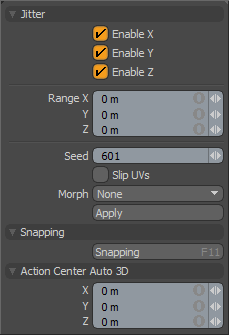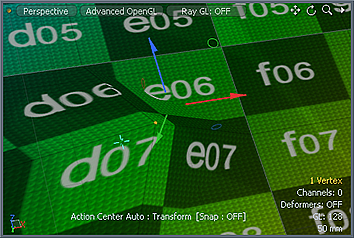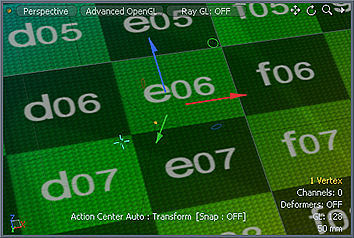
 Found in the 'Deform' subtab of the modeling toolbox (sometimes as a sub-option of the 'Smooth' or 'Quantize' tools), the Jitter tool procedurally repositions selected Items or Components based on a seed number and a range value for X, Y, and Z. Basically it is applying a random offset to each vertex or item position for a more random, organic appearance. Users can interactively apply the Jitter by dragging in the viewport, or numerically entering the values in the Tool Properties Range fields, then click the Apply button. Changing the Seed value will change the random numbers producing a variation on the results. It also employs any active Falloffs allowing users to target specific areas for the jitter application.
Found in the 'Deform' subtab of the modeling toolbox (sometimes as a sub-option of the 'Smooth' or 'Quantize' tools), the Jitter tool procedurally repositions selected Items or Components based on a seed number and a range value for X, Y, and Z. Basically it is applying a random offset to each vertex or item position for a more random, organic appearance. Users can interactively apply the Jitter by dragging in the viewport, or numerically entering the values in the Tool Properties Range fields, then click the Apply button. Changing the Seed value will change the random numbers producing a variation on the results. It also employs any active Falloffs allowing users to target specific areas for the jitter application.
Jitter--
Enable X/Y/Z: Users can enable the random jittering movement on a per axis basis by toggling the option for each axial direction.
Range X/Y/Z: Controls the maximum random offset distance, this value is like adjusting the strength of the jittering effect.
Seed: The 'Seed' value is the initial number used when generating the random procedural values. Each Seed will produce different random results.
Slip Us: UV values are generally fixed to specific vertices, subsequently further edits to the geometry may warp, deform or otherwise distort the UV values in undesirable ways requiring users to adjust the map or redo it altogether. To avoid this undesirable result, users can enable the 'Slip Us' function so as to not disturb any existing UV mapping applied to the geometry.
 'Slip Us' function disabled, note texture warping. |  'Slip Us' function enabled, texture remains even. |
Morph: The Morph option determines how modo treats stored Morph information when applying transforms to geometry (Move, Rotate, Scale, etc.). In previous versions of modo, in order to transform a Morph along with its base, it needed to be selected in the Vertex Map list. If it wasn't, relative Morph map data when recalled would produce distorted, undesirable results. If users were unaware of the requirements, it was easy to accidentally mess up a model. To remedy this problem, there are now three options controlling how the Morph Map vertex data is dealt with when applying any transforms--
None- Morph data is not affected unless selected, working identically to modo 501 and earlier.
Transform- With this option selected, Morph data is transformed along with base mesh.
Keep Positions- With this option Selected, Morph data is converted into a Absolute Morph Map and all vertices retain their pre-transformed positions.
Snapping--
Please reference the 'Snapping' Section of the documentation.
Action Center Auto 3D--
Please reference the 'Action Center' section of the documentation.


